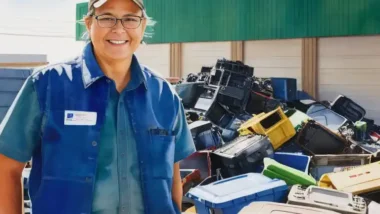Glass crushing is turning waste into biogas fuel for caterers, hotels and pub chains.
How Glass Crushing Works
Glass crushing units are machinery specifically designed to break down glass bottles and other containers into small cullet (crushed glass). These units can be acquired through contacting waste management companies or specialist recycling equipment suppliers.
The crushing process typically involves feeding the glass into a hopper, where it gets crushed by rotating blades or hammers. The resulting cullet exits the machine in a specified size depending on the model.
Extracting Biogas Feedstock
Many glass crushing units are designed to extract liquids trapped within the glass during the crushing process. This liquid, often a mixture of beverage residues, sugars and other organic materials, has a high calorific value, making it ideal as a feedstock for biogas plants.
Biogas plants utilize these organic materials to generate biogas, a clean-burning fuel source that can be used to power generators or even be fed back into the national grid.
Pros of On-Site Glass Crushing
- Reduced Waste Disposal Costs: By crushing their own glass, businesses can significantly reduce the volume of waste they send to landfills, resulting in lower disposal fees.
- Increased Recycling Rates: On-site crushing makes glass recycling more efficient and avoids contamination issues that can occur with mixed recycling streams.
- Biogas Revenue Potential: The extracted liquids can be sold to biogas plants, creating a new revenue stream.
- Environmental Benefits: Glass crushing diverts waste from landfills and contributes to renewable energy production through biogas.
Cons of On-Site Glass Crushing
- Initial Investment: Purchasing and installing a glass crushing unit requires an upfront investment.
- Operational Costs: The unit requires electricity to operate and may involve ongoing maintenance costs.
- Noise Considerations: The crushing process can generate noise, so proper soundproofing or choosing a location away from noise-sensitive areas is crucial.
- Space Requirements: Glass crushing units can be sizeable, requiring adequate space for installation and operation.
Conclusion
For large-scale caterers, hotels and pub chains, on-site glass crushing offers a compelling solution for waste reduction and potential revenue generation. By carefully considering the investment costs and operational requirements, businesses can determine if glass crushing is the right fit for their sustainability goals.
Press Release 150 May 2012 – Archive Version:
Tharsus Glass Crushing Units Under Development will Improve Recycling by Restaurants Bars and clubs
Tharsus Engineering is introducing an innovatory glass crushing unit, for the commercial recycling of glass in a new five year contract win with Ekko Glass Crush and Collect.
The engineering firm has partnered with the Scottish-based recycling experts to design and manufacture their own brand of glass crushing compacting units for use in “hospitality” trade businesses like restaurants, bars, clubs and other licenced traders.
The company in question, Ekko Glass Crush and Collect informs the Waster that they have been piloting the unit with 100 customers that sell consumer glass in large quantities including Network Rail and FTSE 250 bar and restaurant chain, Mitchells and Butlers.
 The built-to-last space-saving units are reportedly smaller than a wheelie bin and reduce glass waste volume by 80% resulting in much smaller storage space requirements between collections.
The built-to-last space-saving units are reportedly smaller than a wheelie bin and reduce glass waste volume by 80% resulting in much smaller storage space requirements between collections.
Tharsus chief executive Brian Palmer said: Ekko Glass Crush and Collect has an excellent business model, which supports the growing need for economically viable methods of recycling waste”.
Working closely with the team at Ekko, we were asked to redesign the product to optimise [it] throughout and satisfy international safety standards, while still meeting their commercial and technical specifications.
Tharsus apparently completely changed the human interface, to make the glass-crushing action safer for users, completely removing the possibility of them coming into contact with glass shards and enhancing the ergonomics and aesthetics by adding a practical curved top to the machine.
Glass Crushing Units Designed for Safety
He continued: “In order to protect the operator we have redesigned the unit so that once the bottle is placed into the chute, the opening is closed off before the machine can crush the glass.â€
When it is available by the end of this year, the new unit will make recycling more time and cost-efficient, crushing all glass in one unit and reducing overall waste disposal costs for businesses.
Brian Williamson, director of Ekko Glass Crush and Collect said: One of the main hurdles to glass being recovered from the hospitality sector is the lack of storage space available at the properties. It is presumed by the Waster that once the available space for glass waste storage is used, without crushing facilities the businesses would need to call in their glass collection service much more frequently, raising recycling costs.
Glass Crushing Units Behind the Bar
The company has stated that; There is an increasing trend for “behind-the-bar” in-house compactors to be used to compact glass before collection which reduces the amount of space required to store the empty bottles and the frequency of collections required”.
Developments of this sort clearly allow the glass to be collected much more sustainably, in larger tonnages per vehicle mile and are very much to be encouraged. The engineering company in this instance has not mentioned the mixing of different glass colours which tends to make the cullet of lower value, but as currently, the Waster understands that most UK glass cullet, whether colour separated or not, is being used as road sub-base aggregate etc., this hardly matters.
Other packaging materials suppliers should take note. Plastic containers and film, could surely be similarly densified/ compacted by these businesses, rendering recycling of these materials also much more viable for recycling by the hospitality trade?
For more information about glass crushing Tharsus and Ekko Glass Collect click here!
[First published as a Press Release on 5 May 2012. Updated May 2024.]






